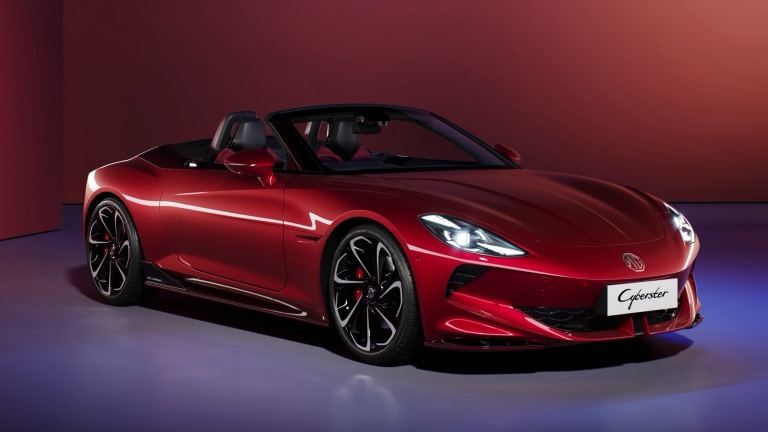
MG has quietly become one of the most prominent value propositions in Australia’s electric vehicle market. The Chinese-owned brand delivers a straightforward offering: accessible pricing, practical packaging and a market-leading warranty. That mix has helped MG move from niche contender to a mainstream option for Australians who want an EV without a luxury price tag.
At a glance, MG currently markets three primary EVs in Australia: the compact MG4 hatch, the entry-level MG ZS EV SUV and the newer, more upmarket MG S5 EV. Across the range the company leans hard into value – the MG4 has been positioned from under $40,000 – and MG backs its electrified lineup with Australia’s longest manufacturer warranty for passenger cars: a 10-year/250,000 km policy that also extends to EV batteries.
MG’s electric vehicle lineup
MG4
The MG4 is a purpose-built electric hatch that sits at the heart of MG’s Australian EV strategy. Designed on a dedicated EV platform, the MG4 focuses on packaging efficiency, keen pricing and usable driving dynamics. It’s offered in multiple specifications and battery capacities (availability varies over time and by market), so range and performance can differ by variant. In markets where larger battery options are sold, MG advertises high WLTP ranges – in Australia expect the long-range variants to comfortably cover daily commuting and longer weekend trips in normal conditions.
MG ZS EV
The MG ZS EV has been the brand’s entry-level SUV and played a significant role in lowering the price barrier for Australian EV buyers. Its strengths are straightforward: a familiar small-SUV layout, decent cabin space and a price point that made it a common first EV choice for households and fleet buyers. While MG has introduced the S5 EV as a replacement in some markets, the ZS EV still represents the accessible end of MG’s EV range where it remains available.
MG S5 EV
Launched as a more premium, modern SUV for MG’s electric catalogue, the S5 EV takes a sportier design approach and steps up on equipment. It includes features expected at this price point such as advanced driver-assistance systems, generous infotainment suites and, in selected variants, vehicle-to-load (V2L) functionality that lets owners run appliances from the car – a handy feature during outdoor recreation and power outages. The S5 EV also benefits from MG’s Modular Scalable Platform, which is engineered for EVs rather than being a converted internal-combustion architecture.
Key features and where MG delivers value
Affordable entry pricing
MG’s core appeal in Australia is value. The MG4’s sub-$40,000 entry position (traditionally the brand’s headline figure) has helped normalise EV ownership for buyers who were waiting for price parity with petrol cars. That affordability has been a major factor in MG’s growing market share in the mainstream EV segment.
Industry-leading warranty
MG offers a 10-year/250,000 km warranty across its passenger car range, and that cover extends to the EV battery. That warranty duration is the longest offered by a major manufacturer in Australia and it provides an extra layer of reassurance for buyers concerned about long-term battery degradation and ownership costs.
Practical EV features
- Vehicle-to-load (V2L): Available on certain models, V2L enables owners to power consumer devices and small appliances from the vehicle – useful for camping, tradespeople and emergency scenarios.
- Dedicated EV architecture: The brand’s Modular Scalable Platform optimises interior space and weight distribution, which improves driving dynamics and packaging compared to adapted petrol platforms.
- Infotainment and safety: MG equips its EVs with large touchscreen displays, smartphone integration and its driver-assistance suite (branded MG Pilot). Higher-spec variants include advanced safety aids such as adaptive cruise, lane-keep assistance and automatic emergency braking.
Charging and real-world range
Charging capability and real-world range vary by model and specification. Larger battery packs sold in some markets achieve higher WLTP figures; Australian figures depend on the specific battery and configuration offered locally. In practice, MG EVs are designed for daily commuting and family needs: most owners will find them adequate for routine urban and regional travel. Charging infrastructure in Australia continues to expand – networks such as Chargefox, Evie and others are rolling out more high-power chargers – but availability can still be uneven outside capital cities, so route planning for longer trips remains sensible.
Ownership considerations: servicing, running costs and incentives
Running costs
EV running costs are generally lower than petrol equivalents due to lower energy costs and reduced servicing needs (fewer moving parts, no oil changes). Insurance and registration remain comparable to other small-to-medium SUVs and hatchbacks; total ownership cost will depend on electricity tariffs, driving habits and access to home charging.
Service and dealer network
MG has been building its dealer and service footprint in Australia. Buyers should confirm local dealer support and parts availability when purchasing, especially in regional areas where service options can differ from metropolitan centres.
Government incentives and stamp duty
State and territory incentives for EVs in Australia remain variable. Some jurisdictions have targeted concessions, rebate programs or stamp duty exemptions for eligible low-emission vehicles. Eligibility thresholds and rules change, so buyers should consult their state government websites or financial advisers to see whether any incentives apply to a specific MG model.
How MG stacks up in the Australian EV market
MG competes in the fiercely contested value segment of the market. Its rivals include more established EV nameplates like Tesla’s Model 3 and mass-market challengers such as BYD, Hyundai and Kia, which offer different combinations of range, tech and brand cachet. MG’s advantage is clear: it undercuts many competitors on price, couples that with a strong warranty and packages practical features that appeal to budget-conscious buyers. The trade-offs tend to be around brand premium, perceived resale values and, for some buyers, advanced tech or ultra-high-performance variants offered by competitors.
Buyer profile
MG’s EVs are well-suited to:
- First-time EV buyers seeking low upfront cost.
- Families wanting an affordable second household vehicle for commuting and local travel.
- Buyers prioritising warranty cover and straightforward value over luxury branding.
Conclusion
MG has established itself as a pragmatic choice for Australians shifting to electric. The combination of accessible pricing, practical packaging and an exceptionally long warranty makes MG’s electric models attractive to mainstream buyers and fleet operators. While MG may not offer the cachet or cutting-edge performance of premium rivals, it convincingly addresses the fundamental barriers many Australians face when considering an EV: cost, support and everyday usability. As charging infrastructure matures and battery technology continues to improve, MG’s value-focused proposition will likely keep it as a strong contender in Australia’s rapidly evolving EV market.
FAQs
Which MG electric models are currently available in Australia?
MG sells multiple electric models in Australia. The principal ones are the MG4 hatch, the MG ZS EV small SUV (entry-level model), and the newer MG S5 EV, which is positioned as a more premium SUV replacement. Model availability and specifications can change, so check with MG Australia or an authorised dealer for the latest line-up.
How long is MG’s warranty on EVs and batteries?
MG provides a 10-year/250,000 km warranty on its passenger vehicles in Australia, and this warranty includes the EV battery. It is one of the longest manufacturer warranties in the Australian market. Always read the warranty terms or speak to a dealer for specific conditions and exclusions.
What kind of range can I expect from an MG EV?
Range depends on the model and battery pack. MG’s dedicated EV platform supports multiple battery options; long-range variants in international WLTP testing can show higher figures, but Australian real-world results typically place long-range MG models in the mid‑hundreds of kilometres per charge, depending on driving conditions, climate and payload. For accurate numbers, refer to the WLTP/Australian test figures for the specific trim.
Do MG EVs support fast charging and vehicle-to-load (V2L)?
Many MG EVs support AC home charging and public DC fast charging; charging speeds vary by model and specification. Selected MG models offer V2L functionality, allowing the car to power external devices. Check the specifications of the exact model you’re considering to confirm its charging capability and whether V2L is included.
Are MG EVs a good buy compared to other brands?
If your priorities are low upfront cost, a long warranty and practical features for everyday use, MG is a compelling option. Buyers seeking premium materials, cutting-edge performance or the strongest projected resale values might prefer other brands. It’s wise to compare total cost of ownership, local dealer support and available incentives when making a decision.
About EV Evolution
EV Evolution is the leading online platform dedicated to Australian electric vehicle owners and enthusiasts. We foster a vibrant community, delivering essential EV news and insights, and enhancing user engagement through our innovative, AI-powered chatbot for dynamic discussions. Our mission is to empower Australian electric vehicle owners and enthusiasts by fostering a vibrant, AI-driven online community that connects, informs, and advances the nation’s electric vehicle landscape.




